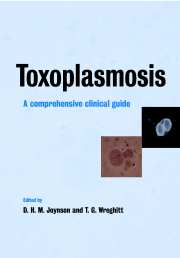Book contents
- Frontmatter
- Contents
- List of contributors
- Preface
- Historical perspective
- 1 Biology of toxoplasmosis
- 2 Immunology of toxoplasma infection
- 3 The epidemiology of toxoplasma infection
- 4 Infection in the immunocompetent
- 5 Toxoplasma infection in HIV-infected patients
- 6 Toxoplasma infection in immunosuppressed (HIV-negative) patients
- 7 Maternal and foetal infection
- 8 Prenatal screening for toxoplasma infection
- 9 Newborn screening for congenital toxoplasma infection
- 10 Infections in neonates and infants
- 11 Ocular infection
- 12 Laboratory diagnosis of toxoplasma infection
- 13 Antitoxoplasma chemotherapy
- 14 Toxoplasma vaccines
- Appendices: protocols for treatment and management
- 1 Suggested treatment protocols
- 2 Management of toxoplasma infection in pregnancy
- 3 Hygiene measures to prevent infection
- 4 Classification system and case definitions of Toxoplasma gondii infection in immunocompetent pregnant women and their congenitally infected offspring
- Index
6 - Toxoplasma infection in immunosuppressed (HIV-negative) patients
Published online by Cambridge University Press: 24 September 2009
- Frontmatter
- Contents
- List of contributors
- Preface
- Historical perspective
- 1 Biology of toxoplasmosis
- 2 Immunology of toxoplasma infection
- 3 The epidemiology of toxoplasma infection
- 4 Infection in the immunocompetent
- 5 Toxoplasma infection in HIV-infected patients
- 6 Toxoplasma infection in immunosuppressed (HIV-negative) patients
- 7 Maternal and foetal infection
- 8 Prenatal screening for toxoplasma infection
- 9 Newborn screening for congenital toxoplasma infection
- 10 Infections in neonates and infants
- 11 Ocular infection
- 12 Laboratory diagnosis of toxoplasma infection
- 13 Antitoxoplasma chemotherapy
- 14 Toxoplasma vaccines
- Appendices: protocols for treatment and management
- 1 Suggested treatment protocols
- 2 Management of toxoplasma infection in pregnancy
- 3 Hygiene measures to prevent infection
- 4 Classification system and case definitions of Toxoplasma gondii infection in immunocompetent pregnant women and their congenitally infected offspring
- Index
Summary
Introduction
Toxoplasma gondii is a classic example of an organism that has re-emerged as a threat to human health due in main to two external factors – the advent of HIV infection (discussed in Chapter 5) and advances in medical techniques and treatment such as transplantation and chemotherapy for malignancy – and the intrinsic ability of the protozoan to produce a persistent but latent infection via tissue cysts.
Toxoplasma gondii infection in an immunocompetent person is usually a trivial event which is normally asymptomatic; severe life-threatening disease is very rare. However, this is not the case in immunosuppressed patients (Table 6.1), in whom toxoplasma infection can result in significant morbidity and mortality. Clinically the situation can be complicated since the symptoms and signs of toxoplasma infection can mimic, confound or compound the presentation of the underlying disease and the possibility of infection may not even be considered. Diagnosis of infection is not always straightforward since the immune response in these patients may be atypical; clinical awareness of the possibility of infection must, therefore, be paramount.
Toxoplasma infection can be acute, chronic, latent or reactivated. Though naturally acquired acute infection can and does occur in immunosuppressed patients, it is not a common occurrence and reactivation of a previously latent infection is the usual scenario. The risk of infection in the individual patient depends on two factors – the prevalence of toxoplasma infection in that particular patient's community and the degree and nature of immunosuppression.
- Type
- Chapter
- Information
- ToxoplasmosisA Comprehensive Clinical Guide, pp. 178 - 192Publisher: Cambridge University PressPrint publication year: 2001
- 5
- Cited by

